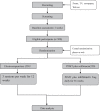Effect of electroacupuncture versus pelvic floor muscle training plus solifenacin for moderate and severe mixed urinary incontinence in women: a study protocol
- PMID: 25128002
- PMCID: PMC4141945
- DOI: 10.1186/1472-6882-14-301
Effect of electroacupuncture versus pelvic floor muscle training plus solifenacin for moderate and severe mixed urinary incontinence in women: a study protocol
Abstract
Background: In women with mixed urinary incontinence, pelvic floor muscle training and solifenacin is the recommended conservative treatment, while electroacupuncture is a safe, economical and effective option.
Methods/design: In this prospective, multi-center, randomized controlled trial, five hundred women with mixed urinary incontinence, from 10 centers will be randomized to receive either electroacupuncture or pelvic floor muscle training plus solifenacin. Women in the acupuncture group will receive electroacupuncture for 3 sessions per week, over 12 weeks, while women in the control group will receive pelvic floor muscle training plus solifenacin (5 mg once daily) for 36 weeks. The primary outcome measure is the proportion of change in 72-hour incontinence episode frequency from baseline to week 12. The secondary outcome measures include eleven items, including proportion of participants with ≥50% decrease in average 72-h incontinence episode frequency, change from baseline in the amount of urine leakage and proportion of change from baseline in 72-h incontinence episode frequency in week 25-36, and so forth. Statistical analysis will include covariance analysis, nonparametric tests and t tests.
Discussion: The objective of this trial is to compare the efficacy and safety of electroacupuncture versus pelvic floor muscle training plus solifenacin in women with moderate and severe mixed urinary incontinence.
Trial registration: ClinicalTrials.gov Identifier: NCT02047032.
References
-
- Gomelsky A, Dmochowski RR. Treatment of mixed urinary incontinence in women. Curr Opin Obstet Gynecol. 2011;23(5):371–375. - PubMed
-
- Haylen BT, de Ridder D, Freeman RM, Swift SE, Berghmans B, Lee J, Monga A, Petri E, Rizk DE, Sand PK, Schaer GN. An international urogynecological association (IUGA)/International continence society (ics) joint report on the terminology for female pelvic floor dysfunction. Int Urogynecol J. 2010;21(1):5–26. doi: 10.1007/s00192-009-0976-9. - DOI - PubMed
-
- Hunskaar S, Burgio K, Clark AL, Lapitan MC. Epidemiology of Urinary (UI) and Faecal (FI) Incontinence and Pelvic Organ Prolapse (POP) Paris: Health Publication Ltd; 2005.
Pre-publication history
-
- The pre-publication history for this paper can be accessed here:http://www.biomedcentral.com/1472-6882/14/301/prepub
Publication types
MeSH terms
Substances
Associated data
LinkOut - more resources
Full Text Sources
Other Literature Sources
Medical


